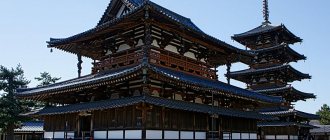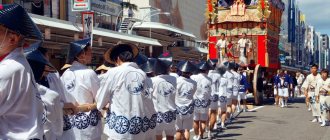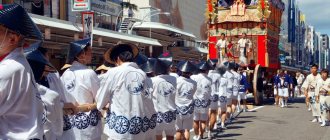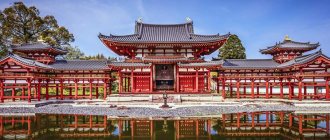In ancient Japan there were many strange traditions that could shock modern people.
In 1600, Tokugawa Ieyasu came to power in Japan, unifying the country and establishing a harsh dictatorship. In 1635, he issued a decree prohibiting the Japanese from leaving the country and returning having already left. And since 1636, he forbade foreigners from setting foot on Japanese soil - they could only stay on the artificial island of Dejima in Nagasaki harbor.
Isolation from the outside world continued for more than 200 years,
and all this time the Japanese maintained very peculiar traditions that could shock any European. Today we will talk about the specific features of ancient Japanese marriage and unusual sexual preferences.
Separated marriage
Living together between spouses was not a typical occurrence in ancient Japan. Much more often a special form of marriage was used - tsumadoi, in which
the husband freely visited his wife, maintaining, in fact, separate residence from her
Such a marriage did not require monogamy from a man; he was not forbidden to have several wives, as well as concubines. However, the law prohibited leaving his wife without a reason to marry a new woman.
The age for marriage was 13 for a boy and 15 for a girl.
Moreover, to create a family, the consent of numerous relatives was required, including grandparents on the wife’s side.
In ancient Japan, a special form of marriage was popular - tsumadoi, in which the husband freely visited his wife. Source pikabu.ru
Hierarchy of priestesses of love
Contrary to popular belief, geishas in Japan were not prostitutes, but rather masters of ceremonies. Wherein
there was a whole class of priestesses of love, who were divided into ranks
Tayu (the most expensive), koshi, tsubone, santya (middle class) and the cheapest - street girls, bath attendants, servants, etc. At the same time, when communicating with courtesans of the upper and middle class, a man had to follow an unspoken rule:
Once you chose a girl, you had to stick with her,
and it is advisable to completely contain it. Therefore, for many Japanese men, prostitutes became a kind of mistress, and relationships with them lasted for many years.
Priestesses of love in ancient Japan were divided into ranks. Source pikabu.ru
Alien paradise A Russian went to Tokyo and almost went crazy
Japan is the absolute West. In an ideological sense, of course. Here, a European will not be confused by all these Asian bells and whistles and an unknown language. What a European, even a Muscovite will feel comfortable and understandable here. Because the future lies in mixing cultures. And here it is already in full swing. The Lenta.ru correspondent flew nine and a half hours to Tokyo, where he spent time in the most atypical way for a tourist in another part of the world. Places for fancy adults? Multi-storey comic book stores for fans of the weird? Sibari after all? No matter how it is!
Thirteen years ago there was no more popular place in Moscow than a sushi bar. And anyone. Huge crowds gathered at every eatery that said “Japanese cuisine” on the door. They were crowded with students, pensioners, out-of-towners, deputies, rogues, children, dogs, and the unemployed. And everyone, like Hachiko, was waiting for the moment when they could order the coveted rolls and teriyaki chicken. Whatever that means.
You could stand in these lines for half an hour, an hour, or half a day. Rain, cold, tornado, wind, scorching sun - they did not pay attention to such nonsense. The process of waiting for a miracle, molded from a lump of rice and a scrap of fish, was the most important event. And the reward in the form of a free table is the highest goal. For the sake of this, everything could be postponed. Because nothing can be more important than touching a dream. It could have caused heartburn or simply indigestion - but the very fact of obtaining a curiosity was above all. The main thing is to possess, not to analyze.
When hookahs, Caesar salad and karaoke rooms appeared in the drying rooms (as the regulars affectionately called them), it became even more interesting. People weren't just fed. They began to frantically please them. The demand for Japanese food was so insatiable that people were willing to buy it at any price. Some establishments took advantage of this and sold a portion of “California” for eight hundred rubles. There were no longer queues in such places. Honorable gentlemen and their ladies with sharp knees went there.
Sushi, rolls and sashimi were considered harmless food, and did not affect the severity of the knees at all. Not like all the burgers out there. “Black Star” was not on them, honestly. Just as there was no doubt that the fashion for Japanese delights will be eternal. And the country itself has become so close to all of us that the word “Jap” in the name of another diner did not seem offensive to its owners. For the time being, really.
The emergence of the most innovative product imaginable (in the hands of PMI CEO Andre Kalandzopoulos)
Photo: IQOS
1/3
Waiting for a miracle is one of humanity’s favorite pastimes. Its most impatient representatives—journalists—came to Tokyo at the end of October to not only wait for the miracle, but also touch it, test it, and properly celebrate its occurrence. Along with rolls and teriyaki chicken, of course. At a conference at the Park Hyatt Tokyo, they were the first in the world to be shown the new IQOS 3 and IQOS 3 Multi. A second later they showed them to the world. At least they brought some benefit.
But with the choice of Japan as the place where new devices will appear to the world, no questions arise. The Japanese still smoke like locomotives, but they prefer something more technologically advanced to banal cigarettes. As a result, 85 percent of the world market for tobacco heating devices is in the land of the rising sun, raw fish and a victorious future.
We even waited for the release of new iPhones, holding our breath a little less often. Everything was more or less clear with them: display, camera, fragile glass, fabulous price. No one could imagine what the third version of the device would be like. Perhaps the developers did not believe that they were creating a spacecraft on the scale of a powder compact.
Everything worked out. The device has become stronger, faster, simpler, more beautiful. This is if we reduce to a few words the half-hour speech of the chief executive officer of Philip Morris International, Andre Kalandzopoulos, which intensified passions and heated the interest of surpassing Steve Jobs and Tim Cook combined. It seems that the company's idea to change everything around is becoming more and more clear. And this form is attractive both in appearance and to the touch. And the meanings that are conveyed to the consumer are becoming clearer and brighter.
It is symbolic that the presentation took place at the hotel where the film “Lost in Translation” was filmed. It’s unlikely, of course, that this was some kind of special idea - probably, there just happened to be a suitable conference room and a good projector. But at some point, simultaneous translation became unnecessary, even though Japanese speech exceeded all norms acceptable for the European ear. In general, everything was clear without words. Like, here, guys, is the future. Global, all-consuming. And it comes, logically, from the East. Here the sun begins to shine earlier, and in general there are a lot of workaholics here. Although all this does not eliminate risks. Let it change a lot.
It's not easy to find something edible in a Seven Eleven grocery store that is similar in shape or even in size
Photo: Alexey Zimin
1/3
The future in Tokyo has arrived too soon indeed. It struck sharply and unexpectedly - when the rest of the planet was still snoring peacefully and was just about to turn over to the other side of technological progress. The Japanese set a very high pace, creating a hole in time. Now it is unclear who is ahead of whom, who is behind whom, and who would be better off keeping quiet. And where is everything going? It is believed that Japan is progressive, and Tokyo is generally a futuristic paradise.
This is true. All the attributes of paradise, as the average onlooker can imagine it, are present here. The surrounding area is clean and green. There are no trash cans anywhere on the streets, but you don’t want to spit out your chewing gum - isn’t that a miracle! Taxi doors open automatically, all cars have lace covers on the seats, they accept credit cards - what a miracle! At the same time, they do not forget about traditions, even if among taxi drivers they are not as centuries-old as those of the local yakuza mafiosi: almost everyone still comes to the line wearing white gloves and driver’s caps.
The Yakuza are also true to tradition. In front of every self-respecting club stands an inconspicuous gray or black sedan with tinted windows and huge chrome wheels. The guys behind the wheel are wearing stern-looking sunglasses. I don’t want to look in their direction again. As well as thinking about how many more of these guys are hiding behind the tint. Obviously, similar thoughts occur to the Japanese. Therefore, they play it safe. Just in case.
For example, people with tattoos are not allowed into public baths. After all, tattoos in Japan for many years were done only by members of the yakuza, and they have their own bathhouses. And it doesn’t matter that if you look like a bandit, then it’s like a guy from Uralmash or Lyubertsy, and not like the hero of a Takeshi Kitano film. It’s also good if the tattoo is small and can be covered with a band-aid. Otherwise, the park will have to be succumbed to in Sanduny.
Many locals wear gauze bandages, and some even wear masks, like Sub Zero from the video game Mortal Kombat, sacred to everyone who grew up in the 1990s. It seems that the Japanese and I had the same childhood. Contrary to popular belief, the Japanese have not slanted eyes at all. They are huge! And the people here are like from a parallel universe. And everyone bows to you. And no one speaks a foreign language. And you bow back and try to repeat the Japanese “konichiwa”, embarrassed by your own pronunciation. Phenomenal.
Taxi drivers do not understand any language other than their native one. Therefore, a cardboard is sewn into the headrests of the front seats, which describes in detail how to communicate with the driver. And beautiful fantasy cases
Photo: Alexey Zimin
1/3
True, if you push the tabernacles a little, this paradise will seem quite cartoonish. It's like the future happened in the past. And the roads and sidewalks are beautiful. But the “My Street” program is missing here. Purely to freshen up the curbstone. The metro is wonderful, music plays in the passages, displays in the cars. But the trains are too tired - not like the Moscow trains with diodes, garlands and beepers. But we did not have the opportunity to use the Tokyo subway during rush hour, when helpful subway workers carefully compact the Japanese rushing to their labor feats.
By the way, you cannot pay for travel by card. This is absolutely disgraceful. In underground ATMs, as luck would have it, you can withdraw at least 10 thousand yen (about five thousand rubles) for a ticket price of 200 yen (about one hundred rubles). But it’s good that the names of the stations are duplicated in English. But here we are not lagging behind with our ulitsa nineteen oh five years!
And the Japanese are sentimental. They still take pictures with emotion in front of the Hachiko monument, adore European holidays and are always ready to carry their drunken boss to a taxi. And bosses here often get drunk. How else to perform feats of labor? Don't waste such an excuse to drink.
Crossroads in Shibuya. The green traffic light turns on simultaneously for crossings in seven directions. And for twelve seconds this place becomes the most congested intersection on Earth
Photo: Alexey Zimin
1/4
#Change everything
Yes, in Tokyo everything is automated and robotic at every step. Skyscrapers are earthquake-resistant, toilets are smart beyond their years. The machines are technologically advanced and innovative. People are hardworking and organized. But it's been like this here for a long time. And all this science and technology for us, people who have recently grasped technology, is pure retrofuturism.
Although, of course, we have adopted a lot of good things from the Japanese. We tried sushi. Inspired by Japanese cars. Mastered Japanese manicure. We've heard enough of Japanese drummers. Lost weight on the Japanese diet. Furnished with Japanese equipment. Appreciated Japanese art. We admired the Japanese polymorphism in intimate matters (but so far, however, only with one eye, here they also innovate too dashingly).
The Japanese also got it from us: Cheburashka, Plushenko, Vitas, the Tatu group. Even this love for characters long forgotten in Russia is very indicative. The Japanese are not yet ready for Pharaoh and Face; we already have them for some reason. But damn, it’s nice when progressive guys are at least somewhat behind you. Or they just don't catch up.
The future that has become our present is everyday life in Japan. Zamyatin’s “We” has long been filmed there, but not in the form of a speculative dystopia, but in a real and everyday way - on an ordinary Tuesday or on a typical Friday.
It’s worth visiting Tokyo at least once to see the world as it should be. A normal world with normal people. Without excesses and outright failures. With the right cultural codes and continuous development. Without aggression and mediocrity. With fashion stores. With its own oddities and translation difficulties. With innovations that change everything.
Suicides for love
Since 1617, all priestesses of love were required to live in separate quarters, following the example of modern “red light districts”. AND
no matter what class the courtesan belonged to, she could not leave her place of work without permission,
although the man was allowed to buy the girl as a wife. But it was so expensive that many lovers simply could not afford to be together. Due to this
there was a widespread phenomenon called “shinju” - couple suicides
The Japanese believed in reincarnation and were sure that they would definitely be together in the next life.
Often a love affair with a courtesan ended in couple suicide. Source Think
Pornography as art
In Japanese culture, there was no consciousness of original sin regarding sex, as there was in Christian cultures. On the contrary, according to ancient Japanese myths, even the emergence of the Japanese islands themselves occurred as a result of the sexual relationship of the god Izanagi and the goddess Izanami. And therefore
Sexual themes in Japanese art originated many centuries ago
and have survived to this day. Explicit intimate scenes can be found in ancient drawings, sculptures, literary materials and oral works. And even now in Japan the hentai genre is quite popular: manga or anime, where
depicts sexual intercourse between humans, monsters or even tentacles
Hentai can be easily purchased from bookstores or movie stores across the country.
Explicit intimate scenes can be found in ancient drawings and sculptures Source Pikabu.
Basics of sex education in modern Japanese society
It should be noted that the previous generation in Japan was brought up according to quite modest rules, but now they try to inform the child on the topic of sex from the age of ten. Because the age of sexual consent in Japan is much lower than in other countries. Discipline has been introduced in schools to teach children the basics of sexual life. In the smallest detail, calling everything by its proper name, teachers try to convey to children the main idea that sex is a way to create a new life. In this way, the Japanese are trying to convey to the younger generation that this physiological process should be viewed not from the point of view of pleasure, but as a vital necessity.
Japanese opinions about such a radical method do not always coincide. This system is subject to a lot of criticism, because it is not yet clear how effective it is. The founder of the system of radical education of schoolchildren was the Imajuku school.
First, children are taught the basics of the physiological process of the human process. Later they begin to talk about the nuances of intimate processes. The average middle school student already knows about the nuances of sexuality, as well as where children come from.
A sufficient amount of time is allocated to intimate discipline in schools - on average twenty hours a year. These lessons are no different from other disciplines; children write essays, perform various tasks, carefully recording everything in their notebooks.
The general education system in Japan is as follows:
- From birth to five years, the child is allowed everything;
- From five to fifteen years of age, children obey their parents unquestioningly. There are a number of rules that must be followed;
- From fifteen years of age and older, a child has the same responsibility as adults, therefore, he is responsible for his actions independently;
Sexual addictions
Sexual relations in ancient Japan were also quite different from European mores.
Netaymori - sushi served on a naked female body can be considered innocent fun
compared to their other inventions. For example, in bukakka, the sperm of several men falls on the face of a woman or a man, and in unagi, a live eel is placed in the woman’s vagina. Tsubashanpu is also very popular among the Japanese - a man experiences sexual pleasure from spitting on the faces of numerous girls. Also
The Japanese are credited with inventing such an important element of BDSM as bondage
By the way, in modern Japan there are institutions offering sadomasochistic services to people if they experience pleasure from pain and humiliation. They also sell and rent sex dolls quite freely.
Sexual relations in ancient Japan were very different from European mores
Unflattering comments from a former student about teaching
Mizuno Tetsuo became a teacher at the age of 25 and worked at a private school for girls. A few years later, in the early 1980s, he invited one of the former graduates, who worked as a midwife, to talk to the schoolchildren. After that, they held a party in her honor, during which she reproached: “The teachers taught us wrong, and we got into trouble.”
She was referring to cases where, after finding a student in possession of a condom, the school decided that "unwanted sexual conduct" was occurring and called a guardian to correct the "sexual promiscuity" and conducted a debriefing with the student. During such a conversation, the student was forced to end such a relationship. Mizuno says: “Such a child was considered “bad,” the authorities said that if we got rid of him, the school would become better, and such instructions were made without any doubt. I myself was ignorant in matters of sex. However, if a person has a condom, then there is knowledge and understanding about sex, and despite this, it was believed that he was leading a wrong life. The guardians in those days did not say anything, and the students did not protest, so as not to attract undue attention from the school.”
Mizuno Tetsuo
Harsh criticism from a former student helped him understand his mistakes, but Mizuno himself was sometimes just as shocked.
“In fact, there were those among teachers who themselves decided not to pursue such a policy. They considered it abnormal and did not follow it. These were not only senior teachers, but also my peers. Working in one organization, I, unlike them, did not connect the concepts of “gender” and “human rights”, educated students regarding gender incorrectly and infringed on their human rights. It terrified me."










